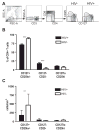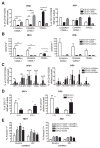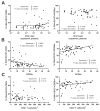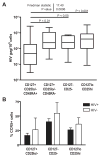CD127 and CD25 expression defines CD4+ T cell subsets that are differentially depleted during HIV infection
- PMID: 18390743
- PMCID: PMC2683429
- DOI: 10.4049/jimmunol.180.8.5582
CD127 and CD25 expression defines CD4+ T cell subsets that are differentially depleted during HIV infection
Abstract
Decreased CD4(+) T cell counts are the best marker of disease progression during HIV infection. However, CD4(+) T cells are heterogeneous in phenotype and function, and it is unknown how preferential depletion of specific CD4(+) T cell subsets influences disease severity. CD4(+) T cells can be classified into three subsets by the expression of receptors for two T cell-tropic cytokines, IL-2 (CD25) and IL-7 (CD127). The CD127(+)CD25(low/-) subset includes IL-2-producing naive and central memory T cells; the CD127(-)CD25(-) subset includes mainly effector T cells expressing perforin and IFN-gamma; and the CD127(low)CD25(high) subset includes FoxP3-expressing regulatory T cells. Herein we investigated how the proportions of these T cell subsets are changed during HIV infection. When compared with healthy controls, HIV-infected patients show a relative increase in CD4(+)CD127(-)CD25(-) T cells that is related to an absolute decline of CD4(+)CD127(+)CD25(low/-) T cells. Interestingly, this expansion of CD4(+)CD127(-) T cells was not observed in naturally SIV-infected sooty mangabeys. The relative expansion of CD4(+)CD127(-)CD25(-) T cells correlated directly with the levels of total CD4(+) T cell depletion and immune activation. CD4(+)CD127(-)CD25(-) T cells were not selectively resistant to HIV infection as levels of cell-associated virus were similar in all non-naive CD4(+) T cell subsets. These data indicate that, during HIV infection, specific changes in the fraction of CD4(+) T cells expressing CD25 and/or CD127 are associated with disease progression. Further studies will determine whether monitoring the three subsets of CD4(+) T cells defined based on the expression of CD25 and CD127 should be used in the clinical management of HIV-infected individuals.
Conflict of interest statement
Figures





Similar articles
-
Blocking Formation of the Stable HIV Reservoir: A New Perspective for HIV-1 Cure.Front Immunol. 2019 Aug 22;10:1966. doi: 10.3389/fimmu.2019.01966. eCollection 2019. Front Immunol. 2019. PMID: 31507594 Free PMC article. Review.
-
Changes in the proportions of CD4(+)T cell subsets defined by CD127 and CD25 expression during HBV infection.Immunol Invest. 2012;41(3):290-303. doi: 10.3109/08820139.2011.631656. Epub 2011 Nov 28. Immunol Invest. 2012. PMID: 22122423
-
Correlates of preserved CD4(+) T cell homeostasis during natural, nonpathogenic simian immunodeficiency virus infection of sooty mangabeys: implications for AIDS pathogenesis.J Immunol. 2007 Feb 1;178(3):1680-91. doi: 10.4049/jimmunol.178.3.1680. J Immunol. 2007. PMID: 17237418
-
Human CD4+ CD25+ CD127hi cells and the Th1/Th2 phenotype.Clin Immunol. 2018 Mar;188:103-112. doi: 10.1016/j.clim.2018.01.003. Epub 2018 Jan 10. Clin Immunol. 2018. PMID: 29330114 Free PMC article.
-
Natural SIV hosts: showing AIDS the door.Science. 2012 Mar 9;335(6073):1188-93. doi: 10.1126/science.1217550. Science. 2012. PMID: 22403383 Free PMC article. Review.
Cited by
-
Immune suppression in premalignant respiratory papillomas: enriched functional CD4+Foxp3+ regulatory T cells and PD-1/PD-L1/L2 expression.Clin Cancer Res. 2012 Apr 1;18(7):1925-35. doi: 10.1158/1078-0432.CCR-11-2941. Epub 2012 Feb 9. Clin Cancer Res. 2012. PMID: 22322668 Free PMC article.
-
Blocking Formation of the Stable HIV Reservoir: A New Perspective for HIV-1 Cure.Front Immunol. 2019 Aug 22;10:1966. doi: 10.3389/fimmu.2019.01966. eCollection 2019. Front Immunol. 2019. PMID: 31507594 Free PMC article. Review.
-
R5-SHIV induces multiple defects in T cell function during early infection of rhesus macaques including accumulation of T reg cells in lymph nodes.PLoS One. 2011 Apr 5;6(4):e18465. doi: 10.1371/journal.pone.0018465. PLoS One. 2011. PMID: 21483689 Free PMC article.
-
Reduced naive CD4 T cell numbers and impaired induction of CD27 in response to T cell receptor stimulation reflect a state of immune activation in chronic hepatitis C virus infection.J Infect Dis. 2011 Mar 1;203(5):635-45. doi: 10.1093/infdis/jiq101. Epub 2011 Jan 10. J Infect Dis. 2011. PMID: 21220773 Free PMC article.
-
Immunological function restoration with lopinavir/ritonavir versus efavirenz containing regimens in HIV-infected patients: a randomized clinical trial.AIDS Res Hum Retroviruses. 2014 May;30(5):425-33. doi: 10.1089/AID.2013.0185. Epub 2014 Feb 10. AIDS Res Hum Retroviruses. 2014. PMID: 24380397 Free PMC article. Clinical Trial.
References
-
- Ho DD, Neumann AU, Perelson AS, Chen W, Leonard JM, Markowitz M. Rapid turnover of plasma virions and CD4 lymphocytes in HIV-1 infection. Nature. 1995;373:123–126. - PubMed
-
- Wei X, Ghosh SK, Taylor ME, Johnson VA, Emini EA, Deutsch P, Lifson JD, Bonhoeffer S, Nowak MA, Hahn BH, et al. Viral dynamics in human immunodeficiency virus type 1 infection. Nature. 1995;373:117–122. - PubMed
-
- Haase AT. Population biology of HIV-1 infection: viral and CD4+ T cell demographics and dynamics in lymphatic tissues. Annu Rev Immunol. 1999;17:625–656. - PubMed
-
- Mohri H, Bonhoeffer S, Monard S, Perelson AS, Ho DD. Rapid turnover of T lymphocytes in SIV-infected rhesus macaques. Science. 1998;279:1223–1227. - PubMed
Publication types
MeSH terms
Substances
Grants and funding
LinkOut - more resources
Full Text Sources
Other Literature Sources
Medical
Research Materials
Miscellaneous

